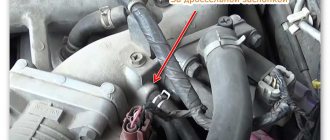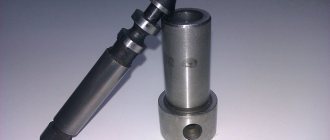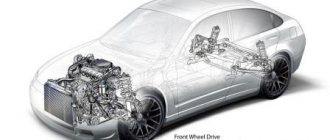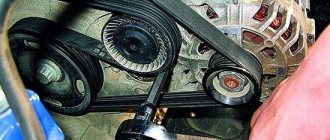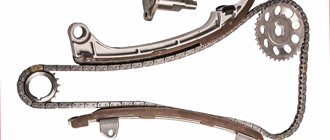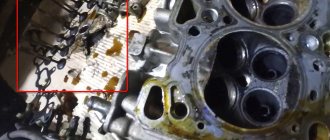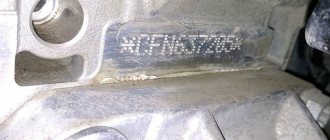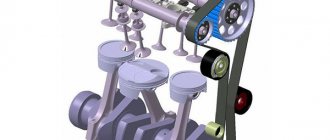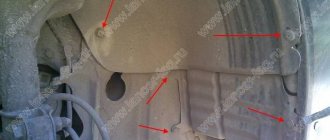08/13/2021 2,835 timing
Author: Victor
A gas distribution mechanism (GDM) is a unit that consists of many structural elements that work synchronously. In this article we will tell you what decoding is used for the timing belt and what the operating principle of the mechanism as a whole is.
[Hide]
What is timing belt?
Before we look at how the timing belt abbreviation is translated and deciphered, let’s consider what the engine gas distribution mechanism in a car is intended for and its operating principle. The timing belt is a distribution device of the car's power unit, used to dose the cylinders with a specified amount of the combustible mixture. The dosing procedure is carried out at certain time intervals.
Device and principle of operation
The assembly itself is represented by the cylinder head of the machine's engine, on which all the structural components of the system are installed - valves, bushings, seats, springs, rockers, camshaft, as well as the housing of bearing devices. Depending on the features and type of power unit, the unit can supply air to the cylinders both with fuel and separately.
The valves are installed in bushings specially designed for their installation, located in the BC head. They are secured using so-called plates, spring elements and locking parts. Rockers with a return spring are mounted on top. There is also a working surface along which the camshaft cams slide, while emitting a minimum of extraneous sounds. The upper structural component is the camshaft installed in bearing devices. On older cars it is mounted in the bearing housing.
Timing belt device
The principle of operation begins with the rotation of the camshaft sprocket, which starts a certain stroke. As a result, the shaft itself comes into operation. It has cams in a certain order, which must correspond to the beat.
When, at startup, the power unit starts working from the first cylinder, cam 1 hits the rocker. The latter overcomes the force of the spring part and lowers the valve to the very bottom. As a result of rotation, the cam jumps off the surface of the rocker, and under the pressure of the spring it moves to its original position. This causes the valve to return, which ultimately closes the combustion chamber. The same happens with other cylinders.
The entire procedure is synchronized with the operation of the crankshaft of the power unit. If one of the valves opens at the wrong time, this will make it impossible to start the engine.
Therefore, the crankshaft is used as a drive for the gas distribution mechanism.
From the video of the channel “Made in a Garage” you can learn about the consequences of a broken timing belt.
Kinds
Gas distribution mechanisms may differ from each other according to the location of the camshaft in the car:
- The camshaft is installed inside the cylinder head, and the valves are located on the top of the head. This allows the elements to trigger the movement of the so-called rocker arms and push rods. The main advantage of such a mechanism is the simplicity of the design and reliability of the system as a whole. The downside is high inertia, as a result of which the power unit is not able to quickly gain speed, which leads to a loss of power.
- The valves can be located in the lower part with the plates facing up. The camshaft is installed at the bottom, the drive comes from it. The advantage of this mechanism is the absence of noise. The main disadvantage is the fuel system, which is complex in design. As a result of poor saturation of the combustion chamber with the air-fuel mixture, engine power is reduced.
- The camshaft can be installed directly in the cylinder head with valves. The elements are located on the sides of the camshaft and begin to work as a result of the influence of rocker arms located on the same axis. These parts rock the cams on the camshaft. The disadvantage of such devices is their high noise level, as well as the difficulty of adjusting valve clearances. In addition, the device operates under high load at the contact point.
- In some power units, the camshaft is installed above the valves, and the plates of these elements are located below. The shaft itself in such motors actuates the valves through pushers located in a cylindrical housing. The main disadvantage of this design is the low elasticity of the unit and the difficulty of adjusting the gaps.
Classification or types of timing belts
Types of timing belts depend on the type of engine. Their main difference is the layout, so you need to know them too. In total, the timing belt classification includes 4 classes.
According to the location of the camshaft
There are lower and upper ones. The first type is now practically not found, since the removal of gases occurs less intensively, but it also has its advantages. For example, the operation of the timing belt and crankshaft is better coordinated this way, since the gas distributor is located right next to it.
With the upper position, the timing belt is located directly at the cylinder head block. So work can be carried out through pushers and rocker arms. Although the coordination and reliability of the connection is lower, the design is simpler, lighter and more compact.
By number of camshafts
The gas distribution mechanism can be with:
- Single shaft (SOHC). In this case, a single camshaft is responsible for both fuel intake and gas exhaust.
- Two shafts (DOHC). One shaft is responsible for intake, the other is for exhaust.
V-shaped engines have 4 shafts, each responsible for its own bank of cylinders.
By number of valves
In total there can be from 2 to 16 (engines with 4 valves are most common). The more there are, the higher the power and dynamic capabilities of the motor.
By drive type
The gas distribution mechanism circuit may include one of 2.5 types of drive:
- On gears. It is used only when the timing belt is located at the bottom (i.e., it is almost never found now). Has a long service life and increased wear resistance. Transmission occurs through sprockets or sixes that are connected to each other.
- Chain. In this case, the driving movement creates a chain, which is fixed on the gears. It is a consumable item and must be changed every 200,000 km.
- Belt. Designed similarly to a chain, but does not require lubrication. Much cheaper and easier to operate, but it wears out completely in just 80,000 km.
What is the purpose of the belt?
The timing belt is a part whose purpose is to act as a connecting link.
Thanks to the timing belt, the camshaft and crankshaft work synchronously, which contributes to the proper functioning of the engine as a whole. This is the need for using a strap.
Markings on the strap
Let's look at a few examples of translating the timing belt decoding:
- ISO-58111x19. The first two numbers (58) encrypt a series of teeth used on the product. In this case, the pitch and profile will be without a groove, the shape will be semicircular, and the height will be 3.5 mm. Then there are three numbers (111), which indicate the number of teeth. By number 19 you can determine the width of the product. There are belts on sale whose teeth are made in the form of a rounded trapezoid.
- 58127x3/4 HSN. Here the first two digits also indicate a series of teeth. The numbers 127 indicate their number, but you need to take into account that in straps belonging to the 40 series, this number is conditional. The numbers 3/4 indicate the width of the product in inches. In this case it is also 19 mm. The HSN mark at the very end indicates that the product is made of durable, highly saturated nitrile. This material has proven its strength. If there are no such letters at the end, then the strap is made of neoprene rubber.
Table: Belt markings
Manufacturers may label their products differently. The table shows how to decipher the timing values.
Decoding belts by car make and engine type
Decoding belts by car brand and engine type
Decoding belts by car brand and engine type
Decoding belts by car brand and engine type
Chain or belt drive
To ensure the rotation of the two shafts, belts or chains are used. Chain transmission was originally used in cars. Chains can have from one to three rows of links, everything depends on the power of the power unit.
Chain: advantages and disadvantages
The advantage of the chain is its long service life. Its stretching is compensated by a specially installed tensioner. Compared to a strap, it lasts much longer.
The chain needs to be replaced only if it is significantly stretched or damaged and breaks, which happens quite rarely.
This is the only advantage of chain transmission.
Disadvantages of such devices:
- The use of a chain affects the noise level of the power unit. Single-row chains don't make as much noise, but two- and three-row chains are louder. Their use contributes to the rather noisy operation of the machine's engine.
- Cylinder blocks that use a chain are more complex in design. Because of this, the procedure for replacing the product becomes much more complicated, since the car owner needs to have direct access to the crankshaft.
Belt: pros and cons
The main advantages of belt drives:
- If the engine is equipped with a timing belt, then such a product will operate much quieter. The driver can only hear one sound when the power unit is operating - the faint knock of valves.
- Easy to replace compared to chain drive. If you are prepared, you can change the belt yourself.
Flaws:
- Low service life of the drive compared to chain transmission. As a result of prolonged use, the strap breaks, and this can cause serious malfunctions. Eight-valve engines practically do not suffer from breaks. In the case of engines equipped with 16 valves, the elements themselves may bend as a result of a break. This will lead to the need for major repairs, the cost of which will be significantly higher than replacing the strap. Sometimes a reduction in service life and a broken belt leads to the formation of cracks in the cylinder head or the cylinder block itself. The only solution to the problem is to install a new cylinder head, and the gasket also changes.
- The need to replace the tension roller along with the belt. In some cases, car owners also need to change the water pump device and a set of washers. The service life of the strap is on average about 60 thousand km. But if you take into account the difficult conditions of use and the presence of defects in many spare parts, experts recommend changing the belt earlier.
On which engines do valves bend most often, and on which ones do not?
The general evil pattern is this: the more complex and expensive the engine, the more destruction a broken belt will create. It is almost guaranteed that the valves will bend on the following engines:
- Modern small-displacement “eco” engines.
- Diesel engines (due to more complex design).
- 16- and 20-valve engines.
- Motors with a chain instead of a timing belt.
But the simplest 4-cylinder 8-valve engines of the old design, not boosted, with a volume of 1.5 liters or more, the most basic gasoline ones, may not suffer if the belt breaks. Another proof that the simpler the design, the more reliable it is.
Video “Service life of timing belts”
You can learn about the actual service life of timing belts from a video filmed by the Avto-Blogger channel.
Do you have any questions? Specialists and readers of the AUTODVIG website will help you ask a question
Was this article helpful?
Thank you for your opinion!
The article was useful. Please share the information with your friends.
Yes (75.00%)
No (25.00%)
X
Please write what is wrong and leave recommendations on the article
Cancel reply
Rate this article: ( 4 votes, average: 4.75 out of 5)
Discuss the article:
